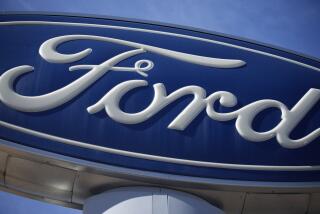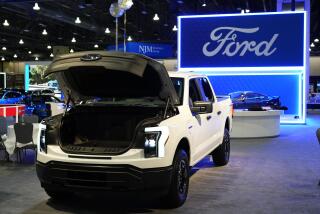This Ford’s Ahead of Its Time
- Share via
Ford is building its 1997 F-150 trucks with 1995 still unwinding, next year unopened and two Christmases yet to be celebrated.
This extended reach--which will allow you to buy a 1997 F-150 this January, sell it 23 months later and still be within the original model year--isn’t some ploy to dilute depreciation.
Ford simply needs the time.
It knows it will take 12 months, even using four plants in two countries, to keep up with predicted demand for the radically rounded, gently enlarged F-150 without unbalancing facilities already turning blue from producing 700,000 full-size trucks a year.
Ford knows it needs caution.
For as with the recent introduction of the 1996 Taurus, there’s a ton of future and loads of prestige riding on the F-150. If this pickup were an athlete, it would be Cal Ripken.
* The F-150 has been the nation’s best-selling vehicle for 13 years. Its numbers are 40% higher than the country’s best-selling car, Ford Taurus, and twice those of Toyota Camry.
* Ford’s F-Series, which includes the F-250 and F-350 pickups, both unchanged for the coming year, has been the nation’s most popular truck for two decades. Chevrolet’s C/K Series is the perennial bridesmaid and usually 10% off Ford’s sales pace.
And with the truck market showing some tremens, Ford needs its winner.
But bet your 1965 Mustang that the F-150 will not only maintain its market lead, but should open additional daylight between its gold medal and the also-rans.
Unlike the new Taurus--which is limping onto the scene and offering little in the way of change beyond its highly argumentative restyling--the F-150 comes roaring to battle with drastically improved looks, burnished mechanicals and a sagely revised concept.
Dual air bags are standard equipment--and two years ahead of the federal mandate for pickups--and the system comes with a key-switch to deactivate the passenger-side bag. That way, baby can be strapped into a rear-facing child seat without fear of getting smooshed if the air bag blows.
The base V-6 engine now makes 205 horsepower, a significant increase on the 145 ponies of yore. More meaningful is the improvement to 255 foot-pounds of torque. Or tugging power vital to any vehicle designed to tote, hump and tow.
An optional, improved V-8 developing 210 horsepower, with 290 foot-pounds of pull, is available. And an even bigger V-8 will be available next year.
Although longer, wider and higher, the F-150 appears smaller (“Har, har, looks like something shrunk by Toyota,” scoffed one gas-pump Gene Siskel) because its planes and corners have been curved and rounded in pleasant tribute to the new Dodge Ram.
Therein an interesting trend in trucks. Squares and sharp edges, as in doorstops and blockhouses, have long symbolized strength and ruggedness. As in trucks.
But biceps aren’t square. Elephants are pretty rounded but have been known to budge houses. Ergo, vehicle designers have realized, full-size pickups may be curved and chamfered and given sloping windshields without reducing any suggestion of toughness.
One bonus to this business of losing slabs and pointy corners is that vehicles move through air more efficiently, which reduces gas consumption. In our test truck, an F-150 XLT with a V-8, the improvement was about 10% to a city-highway average of 19 mpg.
With visual softening--to the levels of a sport utility, say the heavily chromed Ford Explorer, and away from brawny truck shapes, say the Dodge Ram cued by Peterbilt--comes a noticeable tempering of the F-150’s handling and interior appointments.
It was logical progression. Studies show only 14% of truck buyers are plumbers and on-site construction foremen who use their vehicles exclusively as business tools. Few of today’s pickup owners work turnip farms or live on dirt roads across the county line from South Hicksville.
So as a concession to suburbia and the crossover customer, an F-150 may be purchased with fabric headliners and captain’s chairs offering living-room comforts and colors. Cup holders are shaped for juice boxes. And the availability of a crew cab with a third door for back-seaters is Ford’s obvious curtsy to the rising popularity of pickups as family carriers.
No potential buyer goes uncourted by the F-Series. Hence an overpowering smorgasbord of girths and forms; short beds or long, your choice of a V-6 or several V-8s and turbo diesel, Styleside or Flareside, manual or automatic, with or without anti-lock brakes, two- or four-wheel drive, Regular, Super or Crew Cab. And dualies. With base prices starting at $14,400 and stretching to more than $30,000.
Although much of the F-150’s role has been elevated to blazer and button-down, its rough-diamond presence certainly has not been reduced. Suspension travel remains long enough for the vehicle to lurch in balance over uncertain and rutted terrain. Powerful up front, light out back, this rear-driver also puts out some pretty noisy smoke if spurred hard from rest.
The downside is that the perfect compromise remains elusive, and on-road the F-150 is inclined to sponginess. It is not a vehicle one slings around at freeway speeds. Nor is the steering stiff enough to guarantee a stern, firm passage between the dotted lines.
But its 2,435-pound payload is best in class and the little conveniences of bed cleats, lockable tailgate and loading light are strictly workingman. Even beefy 4X4 versions with torsion-bar front suspension and solid rear axle may be fed additional meat and potatoes through a performance package that includes heavy-duty shock absorbers, component shielding and selected spring rates.
All of which is several worlds, one Depression and 70 years removed from Ford’s first pickup. It was a Model T Runabout modified by a cargo box, four stake pockets and heavy-duty rear springs. It cost $281. For an extra $85, you got battery ignition, starter and generator.
Of course, it was the best-selling truck of 1925.
(BEGIN TEXT OF INFOBOX / INFOGRAPHIC)
1997 Ford F-150 XLT
The Good: Revised concept emphasizes show horse, not workhorse. Dual air bags and safety standards ahead of federal mandates. Roomier, with softer, rounder lines that do not dilute muscular mien of full-size truck.
The Bad: Too much pudding in steering and on-road ride.
The Ugly: Size of the threat to Chevrolet.
*
Cost
* Base price: $21,240 (Includes sports-style bed with sidesteps, two air bags with passenger-side deactivation, anti-lock brakes, steel-belted tires, cargo light, rail moldings, locking tailgate, cup holders, power steering and cloth headliner.)
* As tested: $22,211 (Includes four-speed automatic transmission.)
Engine
* 4.6-liter, overhead cam V-8 developing 210 horsepower.
Type
* Front-engine, rear-drive, three-passenger, full-size pickup.
Performance
* 0-60 mph, as tested, 9.2 seconds.
* Top speed, estimated, 110 mph.
* Fuel consumption, city and highway, measured average, 19 mpg.
Curb Weight
* 3,922 pounds.






